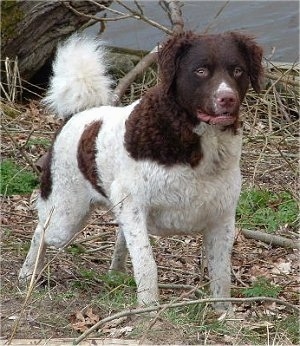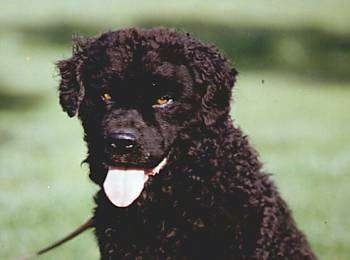
Jelle the Wetterhoun at 2 ½ years old
Wet er houn
The coarse, thick, curly hair of the Wetterhoun covers the entire body except the head and legs, which have shorter hair. The coat is oily and must not be wooly. Coat colors include: liver and white, black and white, solid liver or solid black. The body is somewhat square in appearance. It has a large, strong head. The eyes are prominent and alert. The chest is very broad, keeping the forelegs apart. The hocks are closer to the ground than other water dogs. The feet are rounded and quite large, with pronounced, thick pads. The tail is tightly curled over its back when the dog is alert.
The Wetterhoun is not a suitable dog for beginners. This rugged and soundly built working water dog is an unsinkable capable, canine. It is an all-weather, all-purpose dog that is a popular canine companion and farmhand in its native Holland. It is physically very demanding of itself and can be sensitive. Intelligent and somewhat independent, often with a mind of its own. It is brave, reliable and very watchful. These dogs learn quickly, but they are independent-minded enough to refuse your commands if you are not assertive in a calm manner at all times toward the dog. A consistent but kind approach is absolutely essential. It is strong-willed and needs a firm pack leader. Do not allow this dog to take over the house. Its guarding instinct is still sharp, so training from an early age is imperative. Depending upon the individual dog, corrective action may be appropriate. For its own people, the Wetterhoun is a good-natured and friendly dog. It is good with children in the family, provided the family displays proper leadership, including the children and the children do not tease or harass the dog. It tends to be wary of strangers. This breed makes a good guard dog. Family and friends will get a hearty welcome. It will accept other dogs and pets with no problem.
Height: 21 - 23 inches (53 - 58 cm)
Weight: 33 - 44 pounds (15 - 20 kg)
--
The Wetterhoun is not recommended for apartment life. This breed will be very distressed in an apartment in a busy urban area because these dogs are not suited to such a life. They are rarely seen outside a country setting. The Wetterhoun can live outdoors in a kennel as long as it gets adequate exercise and contact with its humans. It will do well in cold climates as long as it has adequate shelter.
The Wetterhoun needs lots of exercise, which includes a daily, long, brisk walk. The ideal situation for this dog is to have a large piece of land that it can run around on freely...and which it will protect vigorously. The Wetterhoun likes to swim.
About 12-13 years
About 3 to 7 puppies
This water dog requires little grooming. Comb and brush occasionally. Check that the ears are clean and infection free.
Wetterhoun is Dutch for "water dog." Developed by the efficient breeders of the Dutch province of Friesland at least 400 years ago, this rare breed is seldom seen outside its native land. It was most likely descended from the Old Water Dog, a breed that contributed to a number of modern-day spaniel types but is now extinct. The Wetterhoun was developed at the same time as the Stabyhoun. The Wetterhoun specializes in locating and killing otters (the fisherman's competitors for fish). After otters became more manageable in the northern parts of the Netherlands, the breed was used to hunt small land mammals such as polecats, and to guard farms. The Wetterhoun is a rugged, well-built and effective gundog capable of flushing and retrieving on both land and water. He usually hunts singly and hunters attest that he is fearless enough to go face to face with polecats and wildcats as if they do not bite at all.
Gun Dog
Jelle the Wetterhoun is a fast gundog. His nickname in the Netherlands is "Snelle Jelle" (fast Jelle).
Jelle the Wetterhoun practicing water retrieving
Jelle the Wetterhoun showing off his gundog abilities!

An adult black Wetterhoun
Nanning Kornelis van Emelangen the Wetterhoun on the beach with a tennis ball